Assessing Spatiotemporal Characteristics and Driving Factors of Urban Public Buildings Carbon Emissions in China: An Approach Based on LMDI Analysis
Abstract
1. Introduction
- First, this study primarily investigates urban public buildings carbon emissions and constructs a research framework for the spatiotemporal distribution pattern of urban public buildings from 2006 to 2019. This is of great significance for expanding both the breadth and depth of study in the field of urban public buildings.
- Second, through the use of kernel density estimation and spatial autocorrelation analysis, the spatial characteristics and dynamic evolution of regional urban public buildings carbon emissions are studied from a comprehensive perspective of temporal and spatial correlations, providing a more accurate understanding of the regional characteristics of urban public buildings. This fills a previously identified research gap in the limited study of spatial characteristics of carbon emissions in the building sector.
- Third, based on the spatiotemporal LMDI analysis method, the driving factors behind spatial disparities in urban public buildings carbon emissions are analyzed. We consider the impact of per capita urban public building area, population, urbanization rate, economic density, energy efficiency, and energy consumption intensity on urban public buildings carbon emissions in China. The driving mechanisms of these factors and regional disparities in urban public buildings carbon emissions are analyzed in depth. This research gives a theoretical foundation for policymakers to formulate CO2 controlling policies for urban public buildings at the regional level. It is of great significance in balancing regional development and improving CO2 reduction policies, contributing to the achievement of national goals regarding carbon peak and carbon neutrality.
2. Literature Review
2.1. Spatiotemporal Analysis of Carbon Emission
2.2. Driving Factors and Decomposition Method of Carbon Emissions
3. Methodology and Data Source
3.1. Kernel Density Estimation
3.2. Spatial Autocorrelation Analysis
3.3. LMDI Decomposition Model
3.4. Data Source
4. Results and Discussion
4.1. Urban Public Buildings Carbon Emissions
4.2. Kernel Density Estimation Analysis
4.3. Spatial Autocorrelation Analysis
4.3.1. Global Spatial Autocorrelation Analysis
4.3.2. Local Spatial Autocorrelation Analysis
4.4. Driving Factors Decomposition Analysis
5. Conclusions and Policy Suggestions
5.1. Main Findings
- From 2006 to 2019, China’s urban public buildings carbon emissions exhibited a consistent upward trend, reaching 401 million tons in 2006 and 853.23 million tons in 2019. The top-ranking regions in 2019 (Guangdong, Shandong, Heilongjiang, Jiangsu, and Hebei) accounted for nearly 32% of the total emissions. However, the proportions of Ningxia (0.67%), Qinghai (0.8%), and Hainan (0.82%) were less than 2.5% of the total. The provinces experiencing quick growth were primarily concentrated in coastal and economically developed regions, whereas provinces with moderate growth were concentrated in central and northeastern regions. The provinces with slow development were mainly located in the underdeveloped regions of the southwest and northwest. The results show that there are great regional disparities in urban public buildings carbon emissions among provinces.
- The regional disparities in urban public buildings carbon emissions have been gradually increasing. The kernel density estimation curve of 2006 showed a unimodal distribution with the center leaning towards the left. In 2010 and 2015, the summit of the kernel density curve exhibited a gradual decline, and the center shifted to the right. In 2019, the number of areas with high carbon emission values gradually increased. The shape of the kernel density curve exhibited a transformation from being tall and thin to short and wide, indicating an increasing regional disparity in urban public buildings carbon emissions. According to spatial autocorrelation analysis, the spatial positive correlation of urban public buildings carbon emissions is weakening. The spatial pattern of carbon emissions from urban public buildings is primarily characterized by significant high-high clusters provinces. Moreover, the spatial pattern remains relatively steady, and was characterized by significant high-high clusters in northeast and north China regions and low-low clusters in western regions.
- Per capita urban public building area, economic density, urbanization rate, and population are the driving factors for urban public buildings carbon emissions. Their impacts on carbon emissions from urban public buildings decreased successively. Energy efficiency and energy consumption intensity are the major driving factors for reducing urban public buildings carbon emissions. Due to regional disparities in development, different regions showed different sensitivity to these factors. In the northeastern region, energy consumption intensity provides a considerable negative influence on urban public buildings carbon emissions. In the western and central regions, per capita urban public building area and urbanization rate shows a strong promoting influence on urban public buildings carbon emissions. In the eastern coastal region, both economic density and population contribute positively to urban public buildings carbon emissions. Furthermore, energy efficiency and energy consumption intensity exert the suppressing effect on urban public buildings carbon emissions.
5.2. Policy Suggestions
Author Contributions
Funding
Institutional Review Board Statement
Informed Consent Statement
Data Availability Statement
Conflicts of Interest
References
- He, J.; Yue, Q.; Li, Y.; Zhao, F.; Wang, H. Driving force analysis of carbon emissions in China’s building industry: 2000–2015. Sustain. Cities Soc. 2020, 60, 102268. [Google Scholar] [CrossRef]
- Chen, C.; Bi, L. Study on spatio-temporal changes and driving factors of carbon emissions at the building operation stage—A case study of China. Build. Environ. 2022, 219, 109147. [Google Scholar] [CrossRef]
- Zhu, C.; Chang, Y.; Li, X.; Shan, M. Factors influencing embodied carbon emissions of China’s building sector: An analysis based on extended STIRPAT modeling. Energy Build. 2021, 255, 111607. [Google Scholar] [CrossRef]
- BP. BP Statistical Review of World Energy 2021; BP: London, UK, 2021. [Google Scholar]
- Mallapaty, S. How China could be carbon neutral by mid-century. Nature 2020, 586, 482–483. [Google Scholar] [CrossRef] [PubMed]
- CABEE. Annual Research Report on China’s Building Energy Consumption 2021; China Association Building Energy Efficiency: Beijing, China, 2021. [Google Scholar]
- Zhang, S.; Ma, M.; Li, K.; Ma, Z.; Feng, W.; Cai, W. Historical carbon abatement in the commercial building operation: China versus the US. Energy Econ. 2022, 105, 105712. [Google Scholar] [CrossRef]
- CABEE. 2022 Research Report of China Building Energy Consumption and Carbon Emissions; China Association Building Energy Efficiency: Chongqing, China, 2022. [Google Scholar]
- You, K.; Yu, Y.; Cai, W.; Liu, Z. The change in temporal trend and spatial distribution of CO2 emissions of China’s public and commercial buildings. Build. Environ. 2023, 229, 109956. [Google Scholar] [CrossRef]
- Zhou, N.; Khanna, N.; Feng, W.; Ke, J.; Levine, M. Scenarios of energy efficiency and CO2 emissions reduction potential in the buildings sector in China to year 2050. Nat. Energy 2018, 3, 978–984. [Google Scholar] [CrossRef]
- Huo, T.; Xu, L.; Liu, B.; Cai, W.; Feng, W. China’s commercial building carbon emissions toward 2060: An integrated dynamic emission assessment model. Appl. Energy 2022, 325, 119828. [Google Scholar] [CrossRef]
- Lu, M.; Lai, J. Review on carbon emissions of commercial buildings. Renew. Sustain. Energy Rev. 2019, 119, 109545. [Google Scholar] [CrossRef]
- Ma, M.; Yan, R.; Cai, W. An extended STIRPAT model-based methodology for evaluating the driving forces affecting carbon emissions in existing public building sector: Evidence from China in 2000–2015. Nat. Hazards 2017, 89, 741–756. [Google Scholar] [CrossRef]
- Miao, L.; Gu, H.; Zhang, X.; Zhen, W.; Wang, M. Factors causing regional differences in China’s residential CO2 emissions—Evidence from provincial data. J. Clean. Prod. 2019, 224, 852–863. [Google Scholar] [CrossRef]
- McNeil, M.A.; Feng, W.; Can, S.d.l.R.d.; Khanna, N.Z.; Ke, J.; Zhou, N. Energy efficiency outlook in China’s urban buildings sector through 2030. Energy Policy 2016, 97, 532–539. [Google Scholar] [CrossRef]
- Han, M.; Liu, W.; Xie, Y.; Jiang, W. Regional disparity and decoupling evolution of China’s carbon emissions by province. Resour. Sci. 2021, 43, 710–721. [Google Scholar] [CrossRef]
- Li, X.; Wang, J.; Zhang, M.; Ouyang, J.; Shi, W. Regional differences in carbon emission of China’s industries and its decomposition effects. J. Clean. Prod. 2020, 270, 122528. [Google Scholar] [CrossRef]
- Wang, X.; Fan, F.; Liu, C.; Han, Y.; Liu, Q.; Wang, A. Regional differences and driving factors analysis of carbon emissions from power sector in China. Ecol. Indic. 2022, 142, 109297. [Google Scholar] [CrossRef]
- Liu, J.; Li, S.; Ji, Q. Regional differences and driving factors analysis of carbon emission intensity from transport sector in China. Energy 2021, 224, 120178. [Google Scholar] [CrossRef]
- Cui, Y.; Khan, S.U.; Deng, Y.; Zhao, M. Regional difference decomposition and its spatiotemporal dynamic evolution of Chinese agricultural carbon emission: Considering carbon sink effect. Environ. Sci. Pollut. Res. 2021, 28, 38909–38928. [Google Scholar] [CrossRef]
- Liu, J.; Wang, M.J. Study on Calculation and Regional Difference of Carbon Emission of Urban Civil Buildings in China. In Proceedings of the 3rd International Workshop on Advances in Energy Science and Environment Engineering, Suzhou, China, 29–31 March 2019. [Google Scholar]
- Wang, Y.; Wu, X. Research on High-Quality Development Evaluation, Space–Time Characteristics and Driving Factors of China’s Construction Industry under Carbon Emission Constraints. Sustainability 2022, 14, 10729. [Google Scholar] [CrossRef]
- Huo, T.; Li, X.; Cai, W.; Zuo, J.; Jia, F.; Wei, H. Exploring the impact of urbanization on urban building carbon emissions in China: Evidence from a provincial panel data model. Sustain. Cities Soc. 2020, 56, 102068. [Google Scholar] [CrossRef]
- Li, H.; Qiu, P.; Wu, T. The regional disparity of per-capita CO2 emissions in China’s building sector: An analysis of macroeconomic drivers and policy implications. Energy Build. 2021, 244, 111011. [Google Scholar] [CrossRef]
- Zhang, Y.; Yu, Z.; Zhang, J. Analysis of carbon emission performance and regional differences in China’s eight economic regions: Based on the super-efficiency SBM model and the Theil index. PLoS ONE 2021, 16, e0250994. [Google Scholar] [CrossRef] [PubMed]
- Liu, X.; Yang, X.; Guo, R. Regional Differences in Fossil Energy-Related Carbon Emissions in China’s Eight Economic Regions: Based on the Theil Index and PLS-VIP Method. Sustainability 2020, 12, 2576. [Google Scholar] [CrossRef]
- Gan, L.; Liu, Y.; Shi, Q.; Cai, W.; Ren, H. Regional inequality in the carbon emission intensity of public buildings in China. Build. Environ. 2022, 225, 109657. [Google Scholar] [CrossRef]
- Chen, H.; Du, Q.; Huo, T.; Liu, P.; Cai, W.; Liu, B. Spatiotemporal patterns and driving mechanism of carbon emissions in China’s urban residential building sector. Energy 2023, 263, 126102. [Google Scholar] [CrossRef]
- Wang, S.; Liu, H.; Pu, H.; Yang, H. Spatial disparity and hierarchical cluster analysis of final energy consumption in China. Energy 2020, 197, 117195. [Google Scholar] [CrossRef]
- Liu, H.; Song, Y. Financial development and carbon emissions in China since the recent world financial crisis: Evidence from a spatial-temporal analysis and a spatial Durbin model. Sci. Total Environ. 2020, 715, 136771. [Google Scholar] [CrossRef]
- Wang, C.; Guo, Y.; Shao, S.; Fan, M.; Chen, S. Regional carbon imbalance within China: An application of the Kaya-Zenga index. J. Environ. Manag. 2020, 262, 110378. [Google Scholar] [CrossRef]
- Li, W.; Dong, F.; Ji, Z. Research on coordination level and influencing factors spatial heterogeneity of China’s urban CO2 emissions. Sustain. Cities Soc. 2021, 75, 103323. [Google Scholar] [CrossRef]
- Wang, S.; Huang, Y.; Zhou, Y. Spatial spillover effect and driving forces of carbon emission intensity at the city level in China. J. Geogr. Sci. 2019, 29, 231–252. [Google Scholar] [CrossRef]
- Li, W.; Sun, W.; Li, G.; Cui, P.; Wu, W.; Jin, B. Temporal and spatial heterogeneity of carbon intensity in China’s construction industry. Resour. Conserv. Recycl. 2017, 126, 162–173. [Google Scholar] [CrossRef]
- Bai, J.; Qu, J. Investigating the spatiotemporal variability and driving factors of China’s building embodied carbon emissions. Environ. Sci. Pollut. Res. 2021, 28, 19186–19201. [Google Scholar] [CrossRef] [PubMed]
- Li, T.; Gao, H.; Yu, J. Analysis of the spatial and temporal heterogeneity of factors influencing CO2 emissions in China’s construction industry based on the geographically and temporally weighted regression model: Evidence from 30 provinces in China. Front. Environ. Sci. 2022, 10, 1057387. [Google Scholar] [CrossRef]
- Gong, Y.; Song, D. Life Cycle Building Carbon Emissions Assessment and Driving Factors Decomposition Analysis Based on LMDI—A Case Study of Wuhan City in China. Sustainability 2015, 7, 16670–16686. [Google Scholar] [CrossRef]
- Jiang, B.; Huang, B.; Zhang, H. Study on Influencing Factors of Construction Industry Carbon Emissions in Jiangsu Province Based on LMDI Model. Environ. Sci. Technol. 2021, 44, 202–212. [Google Scholar] [CrossRef]
- Shahbaz, M.; Loganathan, N.; Muzaffar, A.T.; Ahmed, K.; Ali Jabran, M. How urbanization affects CO2 emissions in Malaysia? The application of STIRPAT model. Renew. Sustain. Energy Rev. 2016, 57, 83–93. [Google Scholar] [CrossRef]
- Nasir, M.A.; Canh, N.P.; Lan Le, T.N. Environmental degradation & role of financialisation, economic development, industrialisation and trade liberalisation. J. Environ. Manag. 2021, 277, 111471. [Google Scholar] [CrossRef]
- Wang, S.; Zhu, X.; Song, D.; Wen, Z.; Chen, B.; Feng, K. Drivers of CO2 emissions from power generation in China based on modified structural decomposition analysis. J. Clean. Prod. 2019, 220, 1143–1155. [Google Scholar] [CrossRef]
- Su, B.; Ang, B. Structural decomposition analysis applied to energy and emissions: Some methodological developments. Energy Econ. 2012, 34, 177–188. [Google Scholar] [CrossRef]
- Rose, A.; Casler, S. Input–Output Structural Decomposition Analysis: A Critical Appraisal. Econ. Syst. Res. 1996, 8, 33–62. [Google Scholar] [CrossRef]
- Hong, J.; Li, C.Z.; Shen, Q.; Xue, F.; Sun, B.; Zheng, W. An Overview of the driving forces behind energy demand in China’s construction industry: Evidence from 1990 to 2012. Renew. Sustain. Energy Rev. 2017, 73, 85–94. [Google Scholar] [CrossRef]
- Liu, Y.; Wang, J.; Wang, X.; Wu, H.; Guo, F.; Song, Y. A study of CO2 emissions in China’s domestic construction industry based on non-competitive input-output. Sustain. Prod. Consum. 2022, 32, 743–754. [Google Scholar] [CrossRef]
- Shi, Q.; Chen, J.; Shen, L. Driving factors of the changes in the carbon emissions in the Chinese construction industry. J. Clean. Prod. 2017, 166, 615–627. [Google Scholar] [CrossRef]
- Xu, W.; Xie, Y.; Xia, D.; Ji, L.; Huang, G. A multi-sectoral decomposition and decoupling analysis of carbon emissions in Guangdong province, China. J. Environ. Manag. 2021, 298, 113485. [Google Scholar] [CrossRef] [PubMed]
- Wu, P.; Song, Y.; Zhu, J.; Chang, R. Analyzing the influence factors of the carbon emissions from China’s building and construction industry from 2000 to 2015. J. Clean. Prod. 2019, 221, 552–566. [Google Scholar] [CrossRef]
- Zheng, X.; Lu, Y.; Yuan, J.; Baninla, Y.; Zhang, S.; Stenseth, N.C.; Hessen, D.O.; Tian, H.; Obersteiner, M.; Chen, D. Drivers of change in China’s energy-related CO2 emissions. Proc. Natl. Acad. Sci. USA 2020, 117, 29–36. [Google Scholar] [CrossRef] [PubMed]
- Ang, B.W. The LMDI approach to decomposition analysis: A practical guide. Energy Policy 2005, 33, 867–871. [Google Scholar] [CrossRef]
- Zhang, W.; Li, K.; Zhou, D.; Zhang, W.; Gao, H. Decomposition of intensity of energy-related CO2 emission in Chinese provinces using the LMDI method. Energy Policy 2016, 92, 369–381. [Google Scholar] [CrossRef]
- Ang, B.W. Decomposition analysis for policymaking in energy: Which is the preferred method? Energy Policy 2004, 32, 1131–1139. [Google Scholar] [CrossRef]
- Ang, B.W.; Choi, K.-H. Decomposition of Aggregate Energy and Gas Emission Intensities for Industry: A Refined Divisia Index Method. Energy J. 1997, 18, 59–73. [Google Scholar] [CrossRef]
- Jiang, R.; Li, R. Decomposition and Decoupling Analysis of Life-Cycle Carbon Emission in China’s Building Sector. Sustainability 2017, 9, 793. [Google Scholar] [CrossRef]
- Ma, M.; Yan, R.; Du, Y.; Ma, X.; Cai, W.; Xu, P. A methodology to assess China’s building energy savings at the national level: An IPAT–LMDI model approach. J. Clean. Prod. 2017, 143, 784–793. [Google Scholar] [CrossRef]
- Lin, B.; Liu, H. CO2 mitigation potential in China’s building construction industry: A comparison of energy performance. Build. Environ. 2015, 94, 239–251. [Google Scholar] [CrossRef]
- Wang, Y.; Song, J.; Yang, W.; Fang, K.; Duan, H. Seeking spatiotemporal patterns and driving mechanism of atmospheric pollutant emissions from road transportation in china. Resour. Conserv. Recycl. 2020, 162, 105032. [Google Scholar] [CrossRef]
- Lu, X.; Kuang, B.; Li, J. Regional difference decomposition and policy implications of China’s urban land use efficiency under the environmental restriction. Habitat Int. 2018, 77, 32–39. [Google Scholar] [CrossRef]
- Zhao, J.; Ji, G.; Yue, Y.; Lai, Z.; Chen, Y.; Yang, D.; Yang, X.; Wang, Z. Spatio-temporal dynamics of urban residential CO2 emissions and their driving forces in China using the integrated two nighttime light datasets. Appl. Energy 2019, 235, 612–624. [Google Scholar] [CrossRef]
- Long, R.; Shao, T.; Chen, H. Spatial econometric analysis of China’s province-level industrial carbon productivity and its influencing factors. Appl. Energy 2016, 166, 210–219. [Google Scholar] [CrossRef]
- Shi, K.; Chen, Y.; Yu, B.; Xu, T.; Chen, Z.; Liu, R.; Li, L.; Wu, J. Modeling spatiotemporal CO2 (carbon dioxide) emission dynamics in China from DMSP-OLS nighttime stable light data using panel data analysis. Appl. Energy 2016, 168, 523–533. [Google Scholar] [CrossRef]
- Su, Y.; Chen, X.; Li, Y.; Liao, J.; Ye, Y.; Zhang, H.; Huang, N.; Kuang, Y. China’s 19-year city-level carbon emissions of energy consumptions, driving forces and regionalized mitigation guidelines. Renew. Sustain. Energy Rev. 2014, 35, 231–243. [Google Scholar] [CrossRef]
- Meng, Q.; Zheng, Y.; Liu, Q.; Li, B.; Wei, H. Analysis of Spatiotemporal Variation and Influencing Factors of Land-Use Carbon Emissions in Nine Provinces of the Yellow River Basin Based on the LMDI Model. Land 2023, 12, 437. [Google Scholar] [CrossRef]
- Huo, T.; Ren, H.; Zhang, X.; Cai, W.; Feng, W.; Zhou, N.; Wang, X. China’s energy consumption in the building sector: A Statistical Yearbook-Energy Balance Sheet based splitting method. J. Clean. Prod. 2018, 185, 665–679. [Google Scholar] [CrossRef]





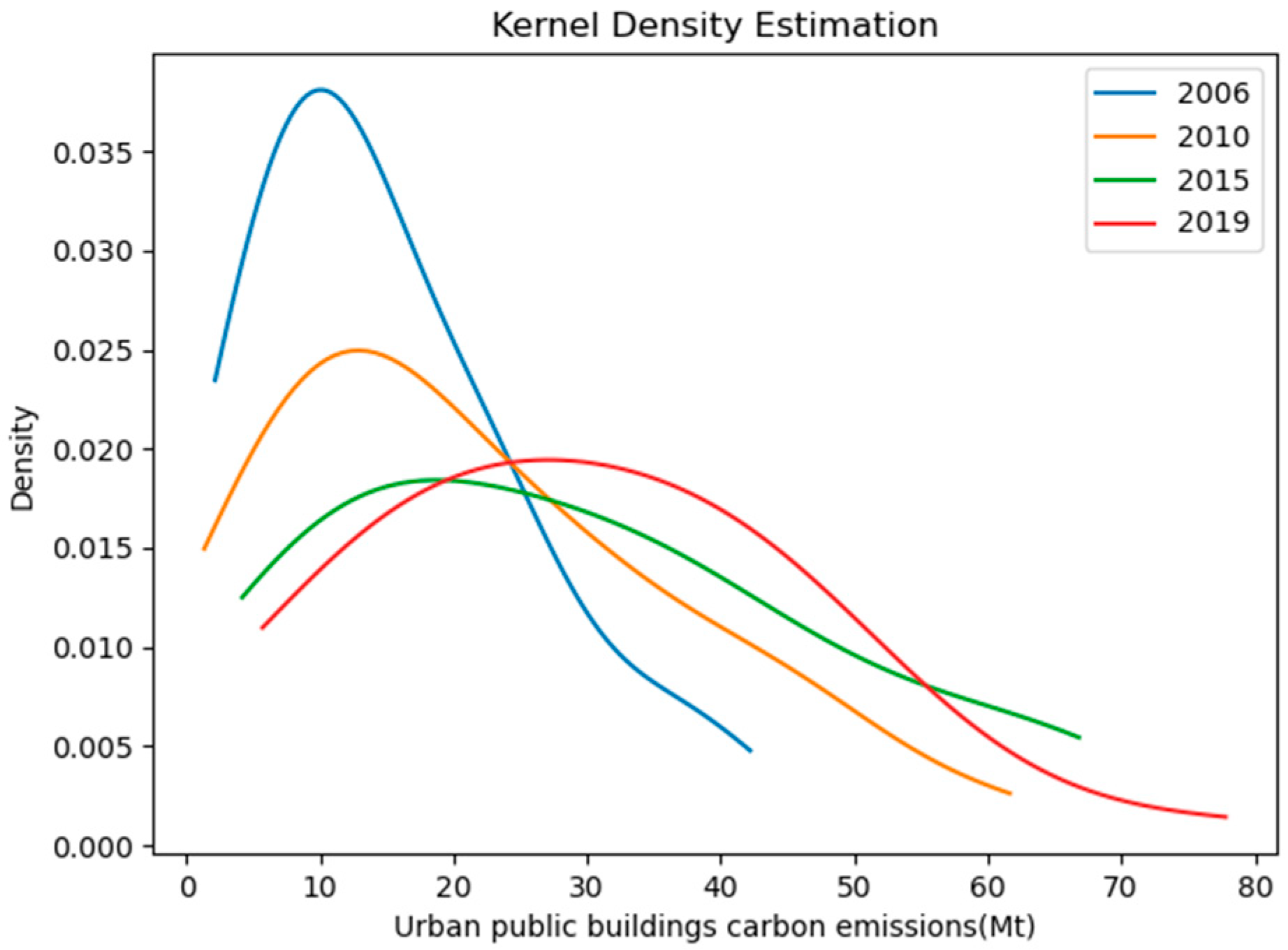


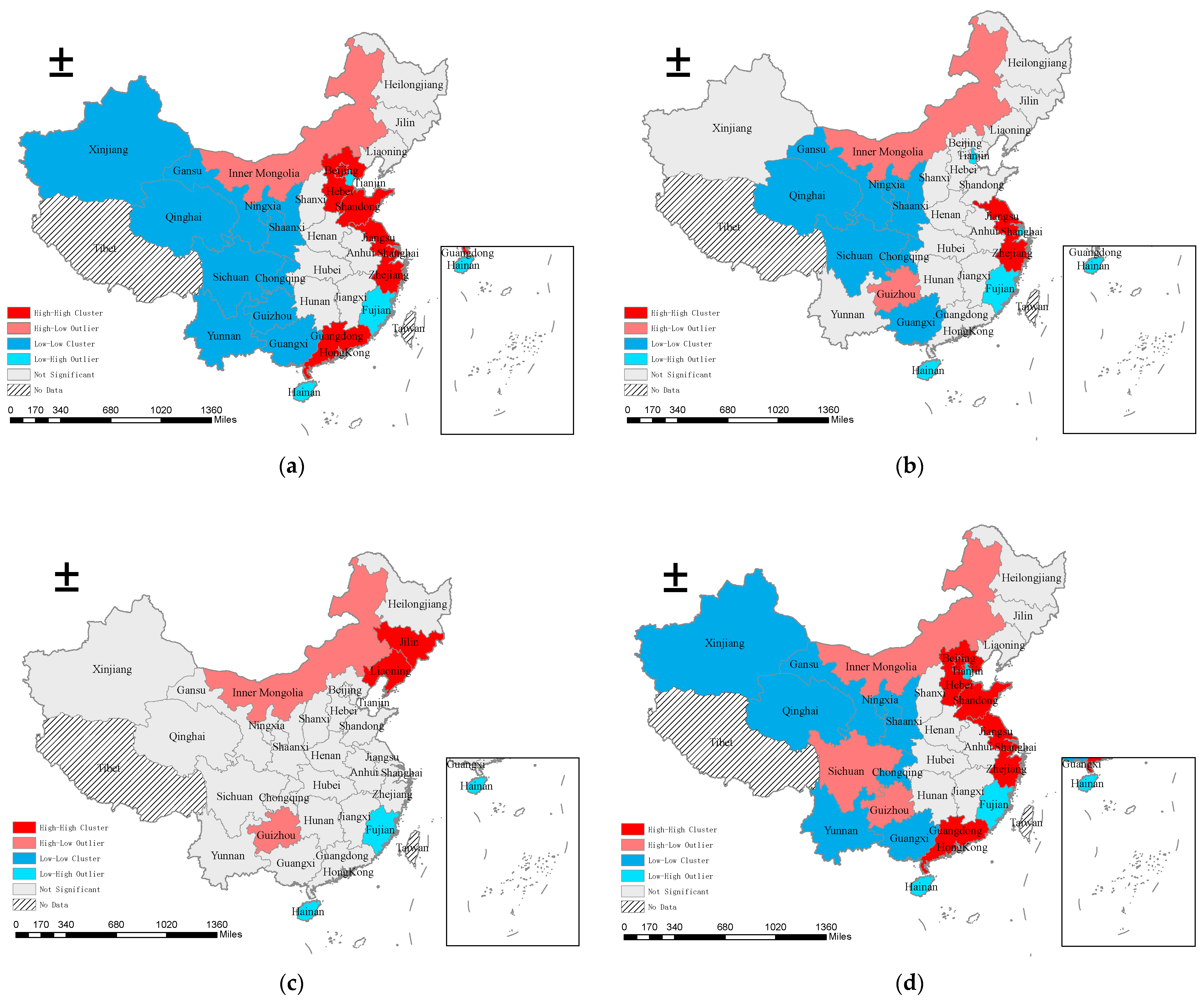

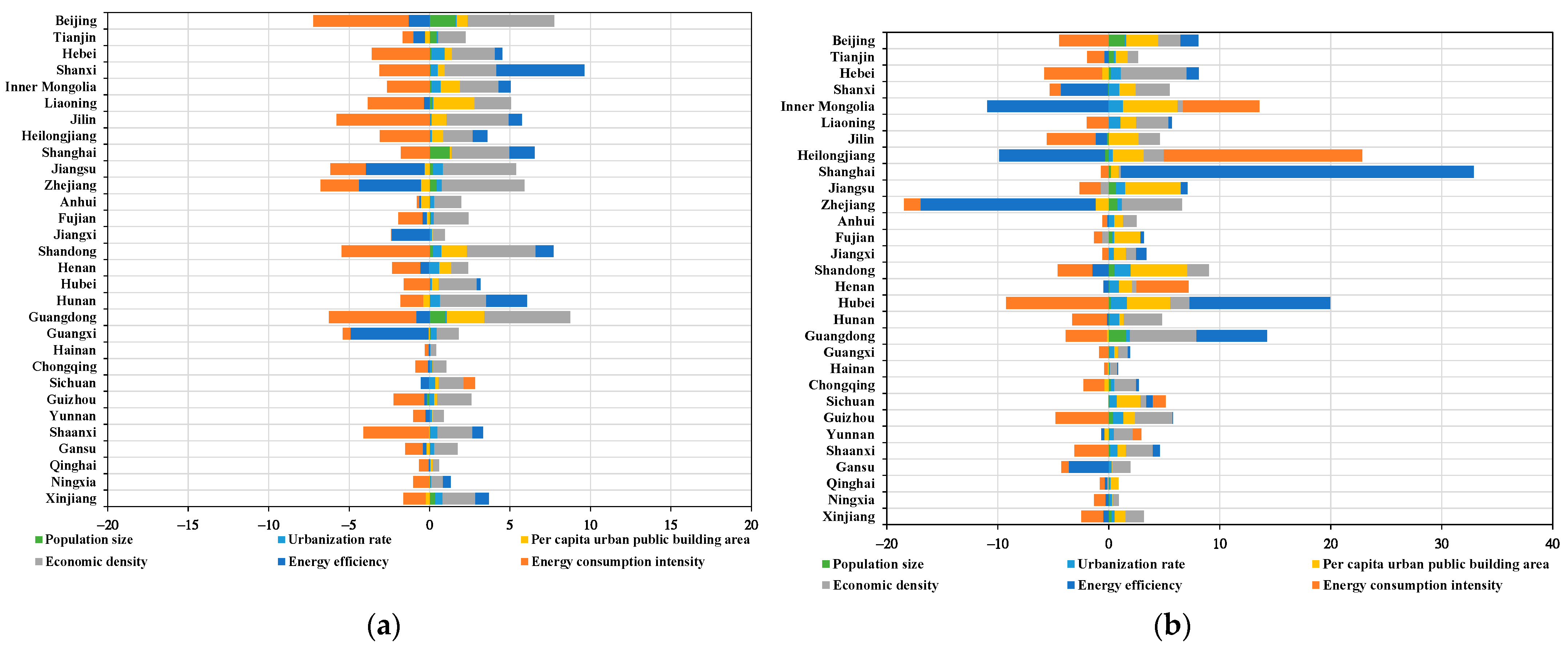
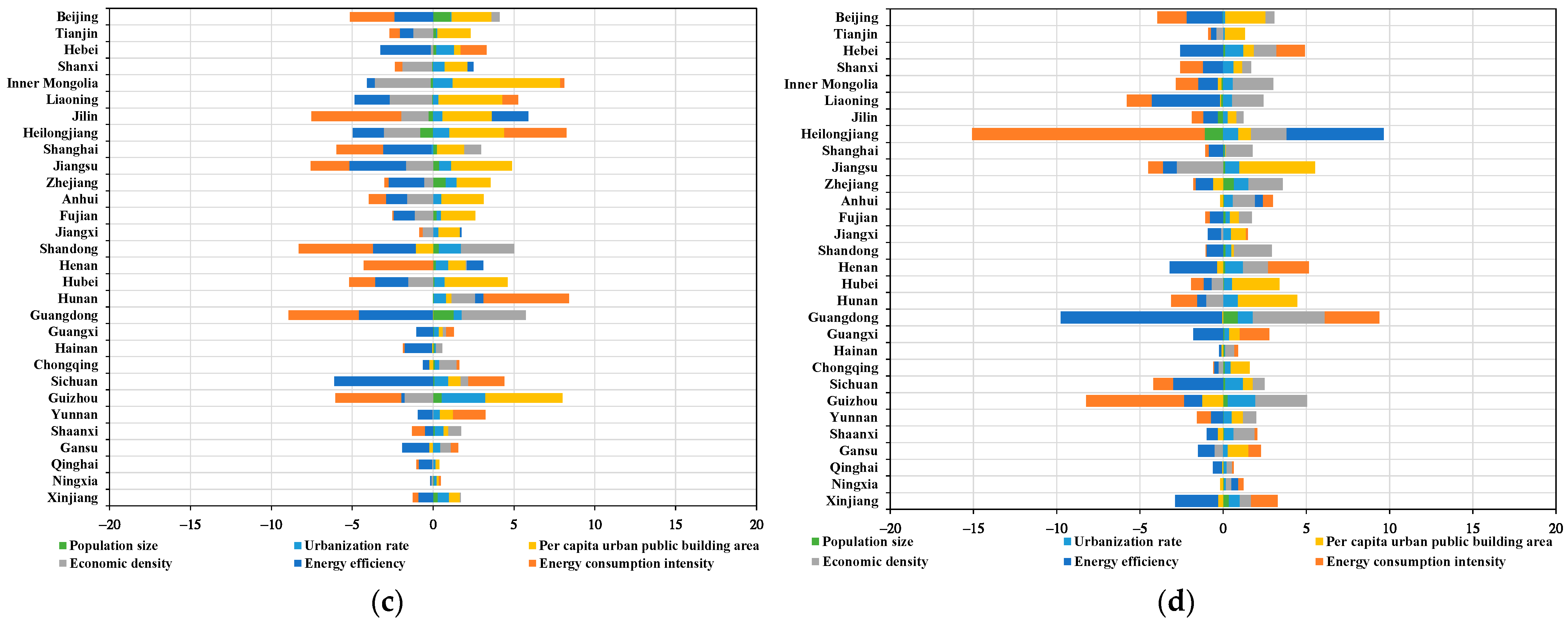
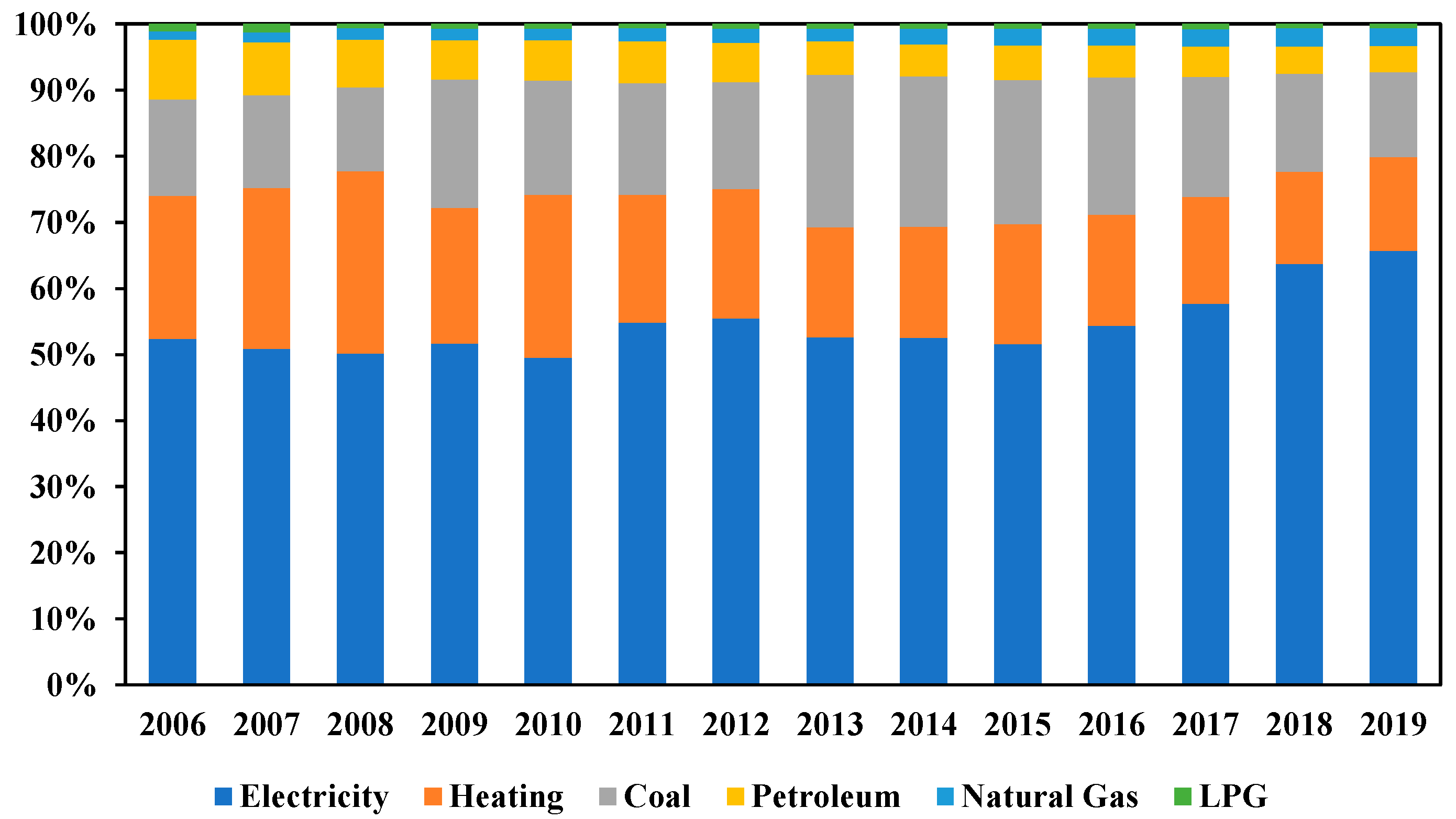
| Region | Province Included in the Region |
|---|---|
| East region | Beijing, Tianjin, Hebei, Shanghai, Jiangsu, Zhejiang, Fujian, Shandong, Guangdong, Hainan |
| Central region | Shanxi, Anhui, Jiangxi, Henan, Hubei, Hunan |
| West region | Inner Mongolia, Guangxi, Chongqing, Sichuan, Guizhou, Yunnan, Shaanxi, Gansu, Qinghai, Ningxia, Xinjiang |
| Northeast region | Liaoning, Jilin, Heilongjiang |
| 2006 | 2007 | 2008 | 2009 | 2010 | 2011 | 2012 | 2013 | 2014 | 2015 | 2016 | 2017 | 2018 | 2019 | |
|---|---|---|---|---|---|---|---|---|---|---|---|---|---|---|
| Beijing | 35.35 | 35.89 | 43.52 | 47.17 | 44.82 | 48.41 | 53.17 | 51.13 | 50.10 | 49.82 | 51.17 | 44.84 | 44.72 | 43.83 |
| Tianjin | 11.71 | 12.28 | 12.85 | 13.22 | 15.02 | 15.71 | 16.90 | 16.44 | 16.06 | 16.24 | 17.39 | 17.48 | 17.40 | 17.81 |
| Hebei | 20.91 | 21.85 | 22.39 | 32.39 | 36.33 | 38.63 | 40.37 | 40.53 | 40.59 | 43.23 | 44.82 | 42.33 | 42.37 | 44.71 |
| Shanxi | 15.01 | 21.50 | 17.54 | 31.81 | 26.63 | 26.79 | 27.80 | 26.68 | 26.84 | 27.68 | 26.34 | 27.94 | 27.51 | 26.61 |
| Inner Mongolia | 18.70 | 21.08 | 22.20 | 36.69 | 45.39 | 48.01 | 59.04 | 63.45 | 67.47 | 65.26 | 51.61 | 33.59 | 41.30 | 41.46 |
| Liaoning | 24.19 | 25.42 | 26.37 | 39.14 | 31.25 | 34.93 | 38.32 | 37.73 | 38.14 | 41.75 | 42.22 | 41.62 | 41.56 | 38.20 |
| Jilin | 20.97 | 20.92 | 21.43 | 19.95 | 24.05 | 23.08 | 24.55 | 30.99 | 29.37 | 35.01 | 35.80 | 30.89 | 22.22 | 21.56 |
| Heilongjiang | 19.10 | 19.60 | 29.67 | 19.41 | 19.92 | 32.89 | 38.43 | 49.02 | 52.32 | 66.83 | 71.22 | 66.64 | 53.87 | 48.43 |
| Shanghai | 23.12 | 27.87 | 29.43 | 30.52 | 1.32 | 33.49 | 34.74 | 35.13 | 32.12 | 30.90 | 31.33 | 32.12 | 32.65 | 33.35 |
| Jiangsu | 25.49 | 24.72 | 29.15 | 26.98 | 32.67 | 37.14 | 41.75 | 37.62 | 34.93 | 35.68 | 38.11 | 42.11 | 47.20 | 48.22 |
| Zhejiang | 27.51 | 26.61 | 28.88 | 38.47 | 42.11 | 30.26 | 34.15 | 43.01 | 43.55 | 38.28 | 35.31 | 37.06 | 39.23 | 41.02 |
| Anhui | 6.45 | 7.61 | 9.14 | 10.15 | 11.28 | 13.23 | 14.91 | 17.15 | 16.30 | 17.54 | 18.16 | 19.98 | 20.27 | 23.07 |
| Fujian | 9.89 | 10.39 | 11.15 | 11.27 | 11.72 | 13.58 | 14.16 | 14.41 | 14.50 | 14.59 | 15.64 | 17.06 | 18.74 | 19.37 |
| Jiangxi | 5.34 | 3.89 | 4.48 | 8.23 | 10.36 | 13.18 | 9.93 | 10.66 | 11.57 | 9.96 | 11.14 | 13.02 | 14.94 | 15.49 |
| Shandong | 35.47 | 37.72 | 37.27 | 54.87 | 61.65 | 66.07 | 76.45 | 58.01 | 54.71 | 55.81 | 56.70 | 56.24 | 50.37 | 52.23 |
| Henan | 11.06 | 11.14 | 11.51 | 12.83 | 13.68 | 20.41 | 22.59 | 24.09 | 22.90 | 25.86 | 29.65 | 23.76 | 30.99 | 32.91 |
| Hubei | 12.19 | 13.75 | 15.80 | 24.95 | 30.32 | 41.02 | 39.49 | 28.95 | 28.39 | 29.48 | 30.03 | 31.52 | 33.82 | 35.28 |
| Hunan | 12.03 | 16.27 | 17.63 | 21.91 | 23.95 | 25.47 | 28.20 | 23.53 | 31.93 | 34.34 | 37.56 | 40.96 | 35.85 | 37.17 |
| Guangdong | 42.20 | 44.67 | 45.78 | 52.60 | 48.47 | 58.83 | 62.90 | 67.61 | 64.42 | 65.35 | 68.05 | 72.09 | 78.18 | 77.81 |
| Guangxi | 10.10 | 6.50 | 7.20 | 8.48 | 8.71 | 9.77 | 10.66 | 9.21 | 9.45 | 10.17 | 10.23 | 11.07 | 12.17 | 13.15 |
| Hainan | 2.13 | 2.25 | 2.61 | 3.03 | 3.13 | 3.59 | 4.18 | 5.69 | 4.39 | 4.66 | 5.02 | 5.53 | 6.41 | 7.06 |
| Chongqing | 5.05 | 5.19 | 5.57 | 7.71 | 8.87 | 9.31 | 11.44 | 10.05 | 11.06 | 7.95 | 12.64 | 10.95 | 13.88 | 14.86 |
| Sichuan | 8.45 | 10.74 | 21.05 | 13.57 | 14.57 | 19.70 | 20.40 | 26.40 | 24.69 | 25.62 | 26.83 | 94.77 | 32.69 | 30.97 |
| Guizhou | 10.39 | 10.76 | 11.01 | 25.35 | 25.94 | 26.95 | 27.93 | 43.36 | 45.32 | 49.05 | 48.48 | 50.83 | 44.42 | 41.22 |
| Yunnan | 4.13 | 3.99 | 3.99 | 6.42 | 7.44 | 9.72 | 11.72 | 12.02 | 14.34 | 14.79 | 15.83 | 16.23 | 18.41 | 18.82 |
| Shaanxi | 12.79 | 12.00 | 12.53 | 16.28 | 18.06 | 19.57 | 20.85 | 18.98 | 19.40 | 19.28 | 19.44 | 19.49 | 20.37 | 21.42 |
| Gansu | 7.74 | 7.97 | 13.35 | 10.94 | 10.85 | 8.55 | 9.52 | 10.85 | 10.50 | 10.92 | 12.75 | 12.19 | 13.13 | 13.89 |
| Qinghai | 2.85 | 2.78 | 2.29 | 3.69 | 4.06 | 4.12 | 4.35 | 4.25 | 3.61 | 4.16 | 4.48 | 6.25 | 6.87 | 6.90 |
| Ningxia | 3.09 | 3.40 | 2.81 | 4.35 | 4.59 | 4.16 | 4.78 | 3.88 | 4.18 | 4.18 | 5.06 | 4.58 | 4.64 | 5.69 |
| Xinjiang | 14.41 | 16.46 | 16.38 | 14.34 | 15.67 | 16.39 | 17.42 | 17.15 | 17.61 | 19.40 | 21.77 | 22.37 | 22.76 | 23.15 |
| Driving Factors | 2006–2007 | 2007–2008 | 2008–2009 | 2009–2010 | 2010–2011 | 2011–2012 | 2012–2013 | 2013–2014 | 2014–2015 | 2015–2016 | 2016–2017 | 2017–2018 | 2018–2019 | Total |
|---|---|---|---|---|---|---|---|---|---|---|---|---|---|---|
| Energy efficiency | −4.50 | −42.01 | 42.09 | −47.06 | 8.28 | −4.14 | −25.63 | −41.56 | −36.74 | −11.91 | 10.98 | −93.37 | −36.43 | −282.00 |
| Energy consumption intensity | −63.46 | 6.91 | 20.89 | −54.25 | −27.15 | −7.80 | −35.74 | −19.05 | 20.75 | −28.87 | −49.32 | −45.45 | −19.44 | −301.97 |
| Economic density | 70.58 | 48.32 | 1.64 | 54.38 | 54.00 | −14.49 | −10.12 | −8.54 | −30.19 | −13.19 | 43.73 | 35.59 | 24.95 | 256.67 |
| Per capita urban public building area | 9.86 | 19.22 | 30.24 | 18.78 | 40.92 | 71.81 | 64.20 | 48.57 | 54.28 | 49.97 | 22.20 | 26.59 | 19.14 | 475.78 |
| Urbanization rate | 8.64 | 10.42 | 9.84 | 24.57 | 16.74 | 16.39 | 19.03 | 18.16 | 22.47 | 21.51 | 20.38 | 18.54 | 16.56 | 223.26 |
| Population | 6.25 | 6.90 | 7.04 | 9.68 | 7.37 | 6.32 | 5.16 | 5.20 | 2.45 | 3.49 | 2.73 | 1.59 | 1.91 | 66.09 |
| Cumulative contribution value | 27.38 | 49.77 | 111.74 | 6.10 | 100.17 | 68.09 | 16.90 | 2.77 | 33.03 | 21.00 | 50.71 | −56.51 | 6.68 | 437.83 |
Disclaimer/Publisher’s Note: The statements, opinions and data contained in all publications are solely those of the individual author(s) and contributor(s) and not of MDPI and/or the editor(s). MDPI and/or the editor(s) disclaim responsibility for any injury to people or property resulting from any ideas, methods, instructions or products referred to in the content. |
© 2023 by the authors. Licensee MDPI, Basel, Switzerland. This article is an open access article distributed under the terms and conditions of the Creative Commons Attribution (CC BY) license (https://creativecommons.org/licenses/by/4.0/).
Share and Cite
Zhang, Z.; Liu, Y.; Ma, T. Assessing Spatiotemporal Characteristics and Driving Factors of Urban Public Buildings Carbon Emissions in China: An Approach Based on LMDI Analysis. Atmosphere 2023, 14, 1280. https://doi.org/10.3390/atmos14081280
Zhang Z, Liu Y, Ma T. Assessing Spatiotemporal Characteristics and Driving Factors of Urban Public Buildings Carbon Emissions in China: An Approach Based on LMDI Analysis. Atmosphere. 2023; 14(8):1280. https://doi.org/10.3390/atmos14081280
Chicago/Turabian StyleZhang, Zhidong, Yisheng Liu, and Tian Ma. 2023. "Assessing Spatiotemporal Characteristics and Driving Factors of Urban Public Buildings Carbon Emissions in China: An Approach Based on LMDI Analysis" Atmosphere 14, no. 8: 1280. https://doi.org/10.3390/atmos14081280
APA StyleZhang, Z., Liu, Y., & Ma, T. (2023). Assessing Spatiotemporal Characteristics and Driving Factors of Urban Public Buildings Carbon Emissions in China: An Approach Based on LMDI Analysis. Atmosphere, 14(8), 1280. https://doi.org/10.3390/atmos14081280







